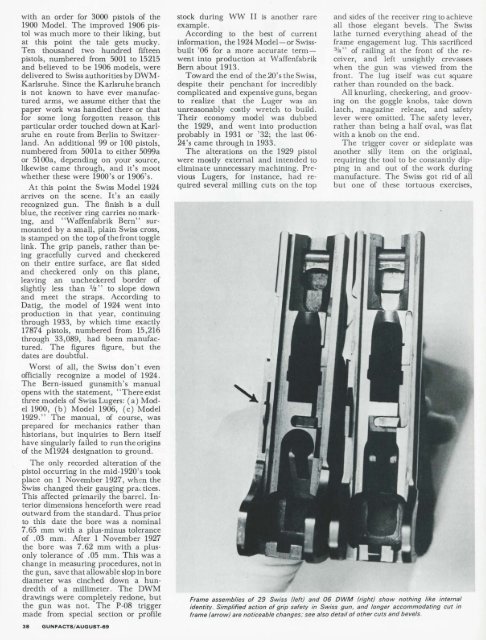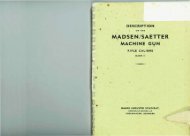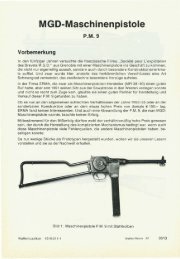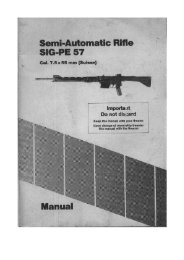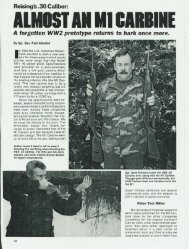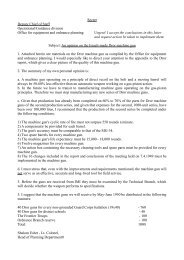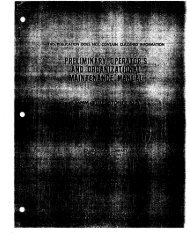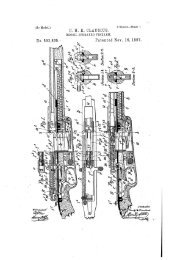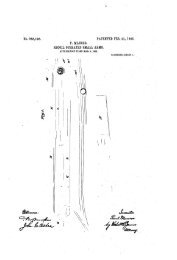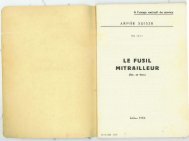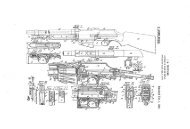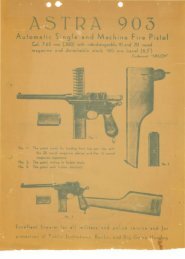The Parabellum Story (GunFacts).pdf - Forgotten Weapons
The Parabellum Story (GunFacts).pdf - Forgotten Weapons
The Parabellum Story (GunFacts).pdf - Forgotten Weapons
You also want an ePaper? Increase the reach of your titles
YUMPU automatically turns print PDFs into web optimized ePapers that Google loves.
with an order for 3000 pistols of the<br />
1900 Model. <strong>The</strong> improved 1906 pistol<br />
was much more to their liking, but<br />
at this point the tale gets mucky.<br />
Ten thousand two hundred fifteen<br />
pistols, numbered from 5001 to 15215<br />
and believed to be 1906 models, were<br />
delivered to Swiss authorities by DWM<br />
Karlsruhe. Since the Karlsruhe branch<br />
is not known to have ever manufactured<br />
arms, we assume either that the<br />
paper work was handled there or that<br />
for some long forgotten reason this<br />
particular order touched down at Karlsruhe<br />
en route from Berlin to Switzerland.<br />
An additional 99 or 100 pistols,<br />
numbered from 5001a to either 5099a<br />
or 5100a, depending on your source,<br />
likewise came through, and it's moot<br />
whether these were 1900's or 1906's.<br />
At this point the Swiss Model 1924<br />
arrives on the scene. It's an easily<br />
recognized gun. <strong>The</strong> finish is a dull<br />
blue, the receiver ring carries no marking,<br />
and "W affenfabrik Bern" surmounted<br />
by a small, plain Swiss cross,<br />
is stamped on the top of the front toggle<br />
link. <strong>The</strong> grip panels, rather than being<br />
gracefully curved and checkered<br />
on their entire surface, are flat sided<br />
and checkered only on this plane,<br />
leaving an uncheckered border of<br />
slightly less than 112" to slope down<br />
and meet the straps. According to<br />
Datig, the model of 1924 went into<br />
production in that year, continuing<br />
through 1933, by which time exactly<br />
17874 pistols, numbered from 15,216<br />
through 33,089, had been manufactured.<br />
<strong>The</strong> figures figure, but the<br />
dates are doubtful.<br />
Worst of all, the Swiss don't even<br />
officially recognize a model of 1924.<br />
<strong>The</strong> Bern-issued gunsmith's manual<br />
opens with the statement, "<strong>The</strong>re exist<br />
three models of Swiss Lugers: (a) Model<br />
1900, (b) Model 1906, (c) Model<br />
1929." <strong>The</strong> manual, of course, was<br />
prepared for mechanics rather than<br />
historians, but inquiries to Bern itself<br />
have singularly failed to run the origins<br />
of the M1924 designation to ground.<br />
<strong>The</strong> only recorded alteration of the<br />
pistol occurring in the mid-1920's took<br />
place on 1 November 1927, when the<br />
Swiss changed their gauging pradices.<br />
This affected primarily the barrel. Interior<br />
dimensions henceforth were read<br />
outward from the standard. Thus prior<br />
to this date the bore was a nominal<br />
7.65 mm with a plus-minus tolerance<br />
of .03 mm. After 1 November 1927<br />
the bore was 7.62 mm with a plusonly<br />
tolerance of .05 mm. This was a<br />
change in measuring procedures, not in<br />
the gun, save that allowable slop in bore<br />
diameter was cinched down a hundredth<br />
of a millimeter. <strong>The</strong> DWM<br />
drawings were completely redone, but<br />
the gun was not. <strong>The</strong> P-08 trigger<br />
made from special section or profile<br />
3 8 GUNFACTS/ AUGUST- 89<br />
stock during WW II is another rare<br />
example.<br />
According to the best of current<br />
information, the 1924 Model-or Swissbuilt<br />
'06 for a more accurate termwent<br />
into production at Waffenfabrik<br />
Bern about 1913.<br />
Toward the end of the 20's the Swiss,<br />
despite their penchant for incredibly<br />
complicated and expensive guns, began<br />
to realize that the Luger was an<br />
unreasonably costly wretch to build.<br />
<strong>The</strong>ir economy model was dubbed<br />
the 1929, and went into production<br />
probably in 1931 or '32; the last 06-<br />
24's came through in 1933.<br />
<strong>The</strong> alterations on the 1929 pistol<br />
were mostly external and intended to<br />
eliminate unnecessary machining. Previous<br />
Lugers, for instance, had required<br />
several milling cuts on the top<br />
and sides of the receiver ring to achieve<br />
all those elegant bevels. <strong>The</strong> Swiss<br />
lathe turned everything ahead of the<br />
frame engagement Jug. This sacrificed<br />
3 /s" of railing at the front of the receiver,<br />
and left unsightly crevasses<br />
when the gun was viewed from the<br />
front. <strong>The</strong> lug itself was cut square<br />
rather than rounded on the back.<br />
All knurling, checkering, and grooving<br />
on the goggle knobs, take down<br />
latch, magazine release, and safety<br />
lever were omitted. <strong>The</strong> safety lever,<br />
rather than being a half oval, was flat<br />
with a knob on the end.<br />
<strong>The</strong> trigger cover or sideplate was<br />
another silly item on the original,<br />
requiring the tool to be constantly dipping<br />
in and out of the work during<br />
manufacture. <strong>The</strong> Swiss got rid of all<br />
but one of these tortuous exercises,<br />
Frame assemblies of 29 Swiss (left) and 06 DWM (right) show nothing like internal<br />
identity. Simplified action of grip safety in Swiss gun, and longer accommodating cut in<br />
frame (arrow) are noticeable changes; see also detail of other cuts and bevels.


